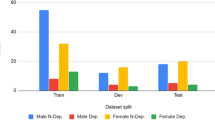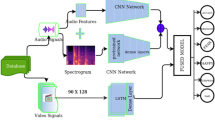Abstract
Recognizing and regulating human emotion or a wave of riding emotions are a vital life skill as it can play an important role in how a person thinks, behaves and acts. Accurate real-time emotion detection can revolutionize the human–computer interaction industry and has the potential to provide a proactive approach to mental health care. Several untapped sources of data, including social media data (psycholinguistic markers), multimodal data (audio and video signals) combined with the sensor-based psychophysiological and brain signals, help to comprehend the affective states and emotional experiences. In this work, we propose a model that utilizes three modalities, i.e., visual (facial expression and body gestures), audio (speech) and text (spoken content), to classify emotion into discrete categories based on Ekman’s model with an additional category for ‘neutral’ state. Transfer learning has been used with multistage fine-tuning for each modality instead of training on a single dataset to make the model generalizable. The use of multiple modalities allows integration of heterogeneous data from different sources effectively. The results of the three modalities are combined at the decision-level using weighted fusion technique. The proposed EmoHD model compares favorably to the state-of-the-art technique on two benchmark datasets MELD and IEMOCAP.







Similar content being viewed by others
Availability of data and materials
Publicly accessible data have been used by the authors.
Code availability
Can be available on request.
References
Picard RW, Vyzas E, Healey J (2001) Toward machine emotional intelligence: analysis of affective physiological state. IEEE Trans Pattern Anal Mach Intell 23(10):1175–1191
Zhang S, Zhang S, Huang T, Gao W, Tian Q (2017) Learning affective features with a hybrid deep model for audio–visual emotion recognition. IEEE Trans Circuits Syst Video Technol 28(10):3030–3043
Kumar A, Sharma K, Sharma A (2021) Hierarchical deep neural network for mental stress state detection using IoT based biomarkers. Pattern Recogn Lett 145:81–87
Gunes H, Pantic M (2010) Automatic, dimensional and continuous emotion recognition. Int J Synthet Emot (IJSE) 1(1):68–99
Szabóová M, Sarnovský M, Maslej Krešňáková V, Machová K (2020) Emotion analysis in human-robot interaction. Electronics 9(11):1761
Rabiei M, Gasparetto A (2014) A system for feature classification of emotions based on speech analysis; applications to human-robot interaction. In: 2014 second RSI/ISM international conference on robotics and mechatronics (ICRoM), pp 795–800. IEEE.
García-Magariño I, Chittaro L, Plaza I (2018) Bodily sensation maps: exploring a new direction for detecting emotions from user self-reported data. Int J Hum Comput Stud 113:32–47
Zhang L, Walter S, Ma X, Werner P, Al-Hamadi A, Traue HC, Gruss S (2016) “BioVid Emo DB”: A multimodal database for emotion analyses validated by subjective ratings. In: 2016 IEEE symposium series on computational intelligence (SSCI) pp 1–6. IEEE.
Bahreini K, Nadolski R, Westera W (2016) Towards multimodal emotion recognition in e-learning environments. Interact Learn Environ 24(3):590–605
Ashwin TS, Jose J, Raghu G, Reddy GRM (2015) An e-learning system with multifacial emotion recognition using supervised machine learning. In: 2015 IEEE seventh international conference on technology for education (T4E), pp 23–26. IEEE.
Ayvaz U, Gürüler H, Devrim MO (2017) Use of facial emotion recognition in e-learning systems. Iнфopмaцiйнi тexнoлoгiï i зacoби нaвчaння, (60, вип. 4), 95–104
Zeng H, Shu X, Wang Y, Wang Y, Zhang L, Pong TC, Qu H (2020) EmotionCues: emotion-oriented visual summarization of classroom videos. IEEE Trans Vis Comput Gr
Tu G, Fu Y, Li B, Gao J, Jiang YG, Xue X (2019) A multi-task neural approach for emotion attribution, classification, and summarization. IEEE Trans Multimedia 22(1):148–159
Hossain MS, Muhammad G (2017) Emotion-aware connected healthcare big data towards 5G. IEEE Internet Things J 5(4):2399–2406
Weitz K, Hassan T, Schmid U, Garbas J (2018) Towards explaining deep learning networks to distinguish facial expressions of pain and emotions. In: Forum Bildverarbeitung, pp 197–208
Saravia E, Liu HCT, Huang YH, Wu J, Chen YS (2018) Carer: contextualized affect representations for emotion recognition. In: Proceedings of the 2018 conference on empirical methods in natural language processing, pp 3687–3697
Ekman P, Friesen W (1977) Facial action coding system: a technique for the measurement of facial movement. Consulting Psychologists Press Stanford University, Palo Alto
Datcu D, Rothkrantz L (2008) Semantic audio-visual data fusion for automatic emotion recognition. Euromedia’2008
De Silva LC, Miyasato T, Nakatsu R (1997) Facial emotion recognition using multi-modal information. In: Information, communications and signal processing, 1997. ICICS., Proceedings of 1997 International Conference on, vol 1. IEEE, 1997, pp 397–401
Datcu D, Rothkrantz LJ (2011) Emotion recognition using bimodal data fusion. In: Proceedings of the 12th international conference on computer systems and technologies. ACM, 2011, pp 122–128
Schuller B (2011) Recognizing affect from linguistic information in 3d continuous space. IEEE Trans Affect Comput 2(4):192–205
Metallinou A, Lee S, Narayanan S (2008) Audio-visual emotion recognition using gaussian mixture models for face and voice. In: Tenth IEEE international symposium on multimedia, 2008. ISM 2008. IEEE, 2008, pp 250–257
Eyben F, Wollmer M, Graves A, Schuller B, Douglas-Cowie E, Cowie R (2010) On-line emotion recognition in a 3-d activation-valence-time continuum using acoustic and linguistic cues. J Multimodal User Interfaces 3(1–2):7–19
Rosas V, Mihalcea R, Morency L-P (1977) Multimodal sentiment analysis of spanish online videos. In: IEEE intelligent systems, vol 28, no. 3, pp. 0038–45, 2013. P. Ekman and W. Friesen, Facial Action Coding System: A Technique for the Measurement of Facial Movement. Consulting Psychologists Press, Stanford University, Palo Alto, 1977.
Rozgic V, Ananthakrishnan S, Saleem S, Kumar R, Prasad R (2012) Speech language & multimedia technol., raytheon bbn technol., Cambridge, Ma, Usa. In: Signal & information processing association annual summit and conference (APSIPA ASC), 2012 Asia-Pacific. IEEE, 2012, pp 1–4
Soleymani M, Pantic M, Pun T (2011) Multimodal emotion recognition in response to videos. IEEE Trans Affect Comput 3(2):211–223
Tzirakis P, Trigeorgis G, Nicolaou MA, Schuller BW, Zafeiriou S (2017) End-to-end multimodal emotion recognition using deep neural networks. IEEE J Sel Top Signal Process 11(8):1301–1309
Ranganathan H, Chakraborty S, Panchanathan S (2016) Multimodal emotion recognition using deep learning architectures. In: 2016 IEEE winter conference on applications of computer vision (WACV), pp 1–9. IEEE
Poria S, Chaturvedi I, Cambria E, Hussain A (2016) Convolutional MKL based multimodal emotion recognition and sentiment analysis. In: 2016 IEEE 16th international conference on data mining (ICDM), pp 439–448. IEEE
Nguyen D, Nguyen K, Sridharan S, Ghasemi A, Dean D, Fookes C (2017) Deep spatio-temporal features for multimodal emotion recognition. In: 2017 IEEE winter conference on applications of computer vision (WACV), pp 1215–1223. IEEE
Poria S, Hazarika D, Majumder N, Naik G, Cambria E, Mihalcea R (2018) Meld: a multimodal multi-party dataset for emotion recognition in conversations. arXiv preprint https://arxiv.org/abs/1810.02508.
Mittal T, Bhattacharya U, Chandra R, Bera A, Manocha D (2020) M3ER: multiplicative multimodal emotion recognition using facial, textual, and speech cues. In: AAAI, pp 1359–1367
Delbrouck JB, Tits N, Dupont S (2020) Modulated fusion using transformer for linguistic-acoustic emotion recognition. arXiv preprint https://arxiv.org/abs/2010.02057
Hagar AF, Abbas HM, Khalil MI (2019) Emotion recognition in videos for low-memory systems using deep-learning. In: 2019 14th international conference on computer engineering and systems (ICCES), pp 16–21. IEEE
Iskhakova A, Wolf D, Meshcheryakov R (2020) Automated destructive behavior state detection on the 1D CNN-based voice analysis. In: International conference on speech and computer, pp 184–193. Springer, Cham
Xie J, Xu X, Shu L (2018) WT feature based emotion recognition from multi-channel physiological signals with decision fusion. In: 2018 first asian conference on affective computing and intelligent interaction (ACII Asia), pp 1–6. IEEE
Gideon J, Khorram S, Aldeneh Z, Dimitriadis D, Provost EM (2017) Progressive neural networks for transfer learning in emotion recognition. arXiv preprint https://arxiv.org/abs/1706.03256.
Ouyang, X., Kawaai, S., Goh, E. G. H., Shen, S., Ding, W., Ming, H., & Huang, D. Y. (2017, November). Audio-visual emotion recognition using deep transfer learning and multiple temporal models. In Proceedings of the 19th ACM International Conference on Multimodal Interaction (pp. 577–582).
Kumar A, Sharma K, Sharma A (2021) Genetically optimized fuzzy C-means data clustering of IoMT-based biomarkers for fast affective state recognition in intelligent edge analytics. Applied Soft Computing, 107525
Tavallali P, et al. (2021) An EM-based optimization of synthetic reduced nearest neighbor model towards multiple modalities representation with human interpretability, multimedia tools and applications
Dresvyanskiy D, Ryumina E, Kaya H, Markitantov M, Karpov A, Minker W (2020) An audio-video deep and transfer learning framework for multimodal emotion recognition in the wild. arXiv preprint https://arxiv.org/abs/2010.03692
Siriwardhana S, Reis A, Weerasekera R, Nanayakkara S (2020) Jointly fine-tuning "BERT-like" self supervised models to improve multimodal speech emotion recognition. arXiv preprint https://arxiv.org/abs/2008.06682
Ekman P (1999) Basic emotions. Handb Cognit Emot 98(45–60):16
Abbas A, Abdelsamea MM, Gaber MM (2020) Detrac: Transfer learning of class decomposed medical images in convolutional neural networks. IEEE Access 8:74901–74913
Huh M, Agrawal P, Efros AA (2016) What makes ImageNet good for transfer learning?. arXiv preprint https://arxiv.org/abs/1608.08614
Busso C, Bulut M, Lee CC, Kazemzadeh A, Mower E, Kim S, Narayanan SS (2008) IEMOCAP: interactive emotional dyadic motion capture database. Lang Resour Eval 42(4):335–359
Li W, Abtahi F, Zhu Z (2015) A deep feature based multi-kernel learning approach for video emotion recognition. In: Proceedings of the 2015 ACM on international conference on multimodal interaction, pp 483–490
Wu Z, Shen C, Van Den Hengel A (2019) Wider or deeper: Revisiting the resnet model for visual recognition. Pattern Recogn 90:119–133
Poria S, Cambria E, Bajpai R, Hussain A (2017) A review of affective computing: from unimodal analysis to multimodal fusion. Inf Fusion 37:98–125
Kumar A, Sharma A, Arora A (2019) Anxious depression prediction in real-time social data. In: International conference on advances in engineering science management & technology (ICAESMT)-2019, Uttaranchal University, Dehradun, India
Hossain MS, Muhammad G (2019) Emotion recognition using deep learning approach from audio–visual emotional big data. Information Fusion 49:69–78
Li W, Tsangouri C, Abtahi F, Zhu Z (2018) A recursive framework for expression recognition: from web images to deep models to game dataset. Mach Vis Appl 29(3):489–502
Acheampong FA, Nunoo-Mensah H, Chen W (2021) Transformer models for text-based emotion detection: a review of BERT-based approaches. Artif Intell Rev, 1–41
Hazarika D, Poria S, Zimmermann R, Mihalcea R (2021) Conversational transfer learning for emotion recognition. Inf Fusion 65:1–12
Funding
No Funding has been received.
Author information
Authors and Affiliations
Contributions
All the authors have equally contributed to the manuscript preparation.
Corresponding author
Ethics declarations
Conflicts of interest
The authors certify that there is no conflict of interest in the subject matter discussed in this manuscript.
Ethics approval
The work conducted is not plagiarized. No one has been harmed in this work.
Consent to participate
All the authors have given consent to submit the manuscript.
Consent for publication
Authors provide their consent for the publication.
Additional information
Publisher's Note
Springer Nature remains neutral with regard to jurisdictional claims in published maps and institutional affiliations.
Rights and permissions
About this article
Cite this article
Sharma, A., Sharma, K. & Kumar, A. Real-time emotional health detection using fine-tuned transfer networks with multimodal fusion. Neural Comput & Applic 35, 22935–22948 (2023). https://doi.org/10.1007/s00521-022-06913-2
Received:
Accepted:
Published:
Issue Date:
DOI: https://doi.org/10.1007/s00521-022-06913-2




